Abstract
Objective
To evaluate the relationship between waist-to-height ratio (WHtR) and glucose and lipid metabolism in Han adolescents aged 13–15 years.
Methods
A study was conducted on 1665 Han adolescents aged 13–15 years. Measurements included height, weight, waist circumference, fasting plasma glucose(FPG), triglyceride and high-density lipoprotein cholesterol. The subjects were divided into two groups according to WHtR.
Results
Compared with the control group (n=1340,WHtR<0.46), the abdominal obesity group(n=325,WHtRe”0.46) had significantly higher levels of body mass index (BMI) (26.3±3.6 vs 18.9±2.3), WHtR (0.51±0.04 vs 0.40±0.03), FPG (4.99±0.48 vs 4.86±0.46), and triglyceride (1.21±0.62 vs 0.87±0.41), and a lower level of high-density lipoprotein cholesterol (1.26±0.27 vs 1.46±0.30) (P<0.01). Logistic regression analysis showed that after controlling for age, sex and BMI, the elevated FPG and dyslipidemia risk odds ratios of the abdominal obesity group were 1.954 (95% CI:1.250∼3.054) and 2.012 (95% CI:1.204∼3.362) (P<0.01) respectively. When clustered, the odds ratio of elevated FPG and dyslipidemia was 6.659 (95% CI: 1.337∼33.159) (P<0.01).
Conclusion
The waist-to-height ratio is an appropriate measure to assess dyslipidemic-diabetic adolescents and should be used to guide early intervention with the aim of future prevention of these linked diseases.
Similar content being viewed by others
References
Ji CY, Sun JL, Chen TJ. Dynamic analysis on the prevalence of obesity and overweight school-age children and adolescents in recent 15 years in China. Chin J Epidemiol 2004;25:103–108.
Flegal, KM, Carroll, MD, Ogden, CL, Johnson, CL. Prevalence and trends in obesity among US adults, 1999–2000. JAMA 2002;288:1723–1727.
Gidding, SS, Bao, W, Srinivasan, SR, Berenson, GS. Effects of secular trends in obesity on coronary risk factors in children: the Bogalusa Heart Study. J Pediatr 1995;127:868–874.
Weili Y, He B, Yao H et al. Waist-to-height ratio is an accurate and easier index for evaluating obesity in children and adolescents. Obesity (Silver Spring) 2007;15:748–752.
McCarthy HD, Ashwell M. A study of central fatness using waist-to-height ratios in UK children and adolescents over two decades supports the simple message—’keep your waist circumference to less than half your height’. Int J Obes (Lond) 2006;30:988–992.
Meng LH, MI J, Cheng H et al. Using waist circumference and waist to height ratio to access central obesity in children and adolescents. Chin J Evid Based Pediatr 2007;2:245–252.
Flegal KM, Carroll MD, Ogden CL, Johnson CL. Prevalence and trends in obesity among US adults, 1999–2000. JAMA 2002;288:1723–1727.
Levine JA. Obesity in China: causes and solutions. Chin Med J 2008;121:1043–1050.
Schneider HJ, Glaesmer H, Klotsche J et al. Accuracy of anthropometric indicators of obesity to predict cardiovascular risk. J Clin Endocrinol Metab 2007;92:589–594.
Garnett SP, Baur LA, Cowell CT. Waist-to-height ratio: a simple option for determining excess central adiposity in young people. Int J Obes 2008;32:1028–1030.
Carr MC, Brunzell JD. Abdominal obesity and dyslipidemia in the metabolic syndrome: importance of type 2 diabetes and familial combined hyperlipidemia in coronary artery disease risk. J Clin Endocrinol Metab 2004;89:2601–2607.
Aekplakorn W, Kosulwat V, Suriyawongpaisal P. Obesity indices and cardiovascular risk factors in Thai adults. Int J Obes 2006;30:1782–1790.
Ashwell M, Hsieh SD. Six reasons why the waist-to-height ratio is a rapid and effective global indicator for health risks of obesity and how its use could simplify the international public health message on obesity. Int J Food Sci Nutr 2005;56:303–307.
Lee CM, Huxley RR, Wildman RP, Woodward M. Indices of abdominal obesity are better discriminators of cardiovascular risk factors than BMI: a meta-analysis. J Clin Epidemiol 2008;61:646–653.
Esmaillzadeh A, Mirmiran P, Azizi F. Waist-to-hip ratio is a better screening measure for cardiovascular risk factors than other anthropometric indicators in Tehranian adult men. Int J Obes Relat Metab Disord 2004;28:1325–1332.
Esmaillzadeh A, Mirmiran P, Azizi F. Comparative evaluation of anthropometric measures to predict cardiovascular risk factors in Tehranian adult women. Public Health Nutr 2006;9:61–69.
Kahn HS, Imperatore G, Cheng YJ. A population-based comparison of BMI percentiles and waist-to-height ratio for identifying cardiovascular risk in youth. J Pediatr 2005;146:482–488.
Lee S, Kuk JL, Hannon TS, Arslanian SA. Race and gender differences in the relationships between anthropometrics and abdominal fat in youth. Obesity (Silver Spring) 2008;16:1066–1071.
Thomas GN, Zhao HL, Ma YQ et al. Relationship between obesity and cardiovascular risk factors in elderly Chinese subjects. Chin Med J 2002;115:897–899.
Lee K, Song YM, Sung J. Which obesity indicators are better predictors of metabolic risk?: healthy twin study. Obesity (Silver Spring) 2008;16:834–840.
Author information
Authors and Affiliations
Corresponding author
Rights and permissions
About this article
Cite this article
Lu, Q., Iseli, T.J., Yin, FZ. et al. The relationship between the waist-to-height ratio and glucose and lipid metabolism in Han adolescents. Indian J Pediatr 77, 547–550 (2010). https://doi.org/10.1007/s12098-010-0054-9
Received:
Accepted:
Published:
Issue Date:
DOI: https://doi.org/10.1007/s12098-010-0054-9




